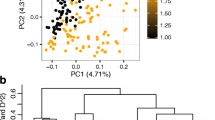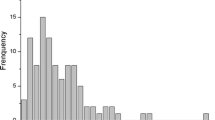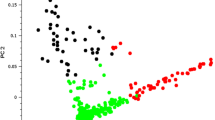Abstract
Global efforts are underway to develop staple crops with improved levels of provitamin A carotenoids to help combat dietary vitamin A deficiency, which is widespread among resource-poor farmers in the developing world. As a staple crop for more than 500 million people in sub-Saharan Africa, cassava (Manihot esculenta Crantz) enriched with provitamin A carotenoids could have immense nutritional impact. To this effort, a genome-wide association study (GWAS) was conducted with the aim of identifying genomic regions controlling variation for carotenoid concentration in cassava as a basis for undertaking systematic genetic improvement for carotenoid content. A high throughput genotyping-by-sequencing platform was used to genotype a diverse association panel of 591 genotypes and identified 179,310 single nucleotide polymorphisms (SNPs) distributed across the cassava genome. A genomic region stretching 1.37 Mb on chromosome 1 was identified with four SNPs significantly associated with carotenoid content in cassava. A survey of cassava genome sequence v6.1 positioned these SNPs in the vicinity of Manes.01G124200.1 locus, which is a known gene responsible for increase in accumulation of provitamin A carotenoids in cassava roots. This study provides one of the pioneer insights into the practical application of GWAS for dissecting the genetic basis of nutritional traits in cassava. Findings presented herein offer practical grounds for improving carotenoid content in cassava through marker-assisted breeding and genomic selection.






Similar content being viewed by others
References
Abdel-Haleem H, Bowman J, Giroux M, Kanazin V, Talbert H, Surber L, Blake T (2010) Quantitative trait loci of acid detergent fiber and grain chemical composition in hulled x hull-less barley. Euphytica 172:405–418
Akinwale MG, Aladesanmwa RD, Akinyele BO, Dixon AGO, Odiyi AC (2010) Inheritance of ß-carotene in cassava (Manihot esculenta Crantz). Int J Genet Mol Biol 2:198–201
Beyer P, Al-Babili S, Ye X, Lucca P, Schaub P, Welsch R, Potrykus I (2002) Golden rice: introducing the beta-carotene biosynthesis pathway into rice endosperm by genetic engineering to defeat vitamin A deficiency. J Nutr 132:506–510
Bishop DT, Williamson JA (1990) The power of identity-by-state linkage methods of analysis. Am J Hum Genet 46:254–265
Bradbury PJ, Zhang Z, Kroon DE, Casstevens TM, Ramdoss Y, Buckler ES (2007) TASSEL: software for association mapping of complex traits in diverse samples. Bioinformatics 23:2633–2635
Browning BL, Browning SR (2013) Improving the accuracy and efficiency of identity by descent detection in population data. Genetics 194:459–471
Burns A, Gleadow R, Cliff J, Zacarias A, Cavagnaro T (2010) Cassava: the drought, war and famine crop in a changing world. Sustainability 2:3572–3607
Ceballos H, Iglesias C, Pérez JC, Dixon AGO (2004) Cassava breeding: opportunities and challenges. Plant Mol Biol 56:503–516
Ceballos H, Kulakow P, Hershey C (2012) Cassava breeding: current status, bottlenecks and the potential of biotechnology tools. Trop Plant Biol 5:73–87
Ceballos H, Morante N, Sánchez T et al (2013) Rapid cycling recurrent selection for increased carotenoids content in cassava roots. Crop Sci 53:23–42
Ceballos H, Kawuki RS, Gracen VE, Yencho GC, Hershey CH (2015) Conventional breeding, marker-assisted selection, genomic selection and inbreeding in clonally propagated crops: a case study for cassava. Theor Appl Genet 128:1647–1667
Clewer AG, Scarisbrick DH (2001) Practical statistics and experimental design for plant crop science. Wiley, Chichester
Crossa J, Beyene Y, Kassa S et al (2013) Genomic prediction in maize breeding populations with genotyping-by-sequencing. G3—Genes Genom Genet 3:1903–1926
Davey JW, Hohenlohe PA, Etter PD, Boone JQ, Catchen JM, Blaxter ML (2011) Genome-wide genetic marker discovery and genotyping using next-generation sequencing. Nat Rev Genet 12:499–510
Dellaporta S, Wood J, Hicks J (1983) A plant DNA minipreparation: version II. Plant Mol Biol Rep 1:19–21
Deschamps S, Llaca V, May GD (2012) Genotyping-by-sequencing in plants. Biology 1:460–483
Edgerton MD (2009) Increasing crop productivity to meet global needs for feed, food, and fuel. Plant Physiol 149:7–13
Elshire RJ, Glaubitz JC, Sun Q, Poland JA, Kawamoto K, Buckler ES, Mitchell SE (2011) A robust, simple genotyping-by-sequencing (GBS) approach for high diversity species. PloS One 6:e19379
Ersoz ES, Yu J, Buckler ES (2009) Applications of linkage disequilibrium and association mapping in maize. In: Kritz AL, Larkins BA (eds) Molecular genetic approaches to maize improvement, vol 63. Springer, Berlin, pp 173–190
Esuma W, Rubaihayo P, Pariyo A et al (2012) Genetic diversity of provitamin A cassava in Uganda. J Plant Stud 1:60–71
Esuma W, Kawuki SR, Herselman L, Labuschagne M (2016) Stability and genotype by environment interaction of provitamin A carotenoid and dry matter content in cassava in Uganda. Breed Sci. doi:10.1270/jsbbs.16004
FAOSTAT (2009) Why cassava? http://www.fao.org/ag/AGP/agpc/gcds/index_en. Accessed on 4 Jan, 2016
Fu Z, Yan J, Zheng Y, Warburton ML, Crouch JH, Li JS (2010) Nucleotide diversity and molecular evolution of the PSY1 gene in Zea mays compared to some other grass species. Theor Appl Genet 120:709–720
Gegios A, Amthor R, Maziya-Dixon B et al (2010) Children consuming cassava as a staple food are at risk for inadequate zinc, iron, and vitamin A intake. Plant Foods Hum Nutr 65:64–70
Giuliano G (2014) Plant carotenoids: genomics meets multi-gene engineering. Curr Opin Plant Biol 19:111–117
Glaubitz JC, Casstevens TM, Lu F, Harriman J, Elshire RJ, Sun Q, Buckler ES (2014) TASSEL-GBS: a high capacity genotyping by sequencing analysis pipeline. PloS One 9:e90346
Goodstein DM, Shu S, Howson R et al (2012) Phytozome: a comparative platform for green plant genomics. Nucleic Acids Res 40:1178–1186
Grady BJ, Torstenson ES, Ritchie MD (2011) The effects of linkage disequilibrium in large scale SNP datasets for MDR. BioData Min 4:11
He J, Zhao X, Laroche A, Lu ZX, Liu H, Li Z (2014) Genotyping-by-sequencing (GBS), an ultimate marker-assisted selection (MAS) tool to accelerate plant breeding. Front Plant Sci 5:484
Hill WG, Weir BS (1988) Variances and covariances of squared linkage disequilibria in finite populations. Theor Popul Biol 33:54–78
Kawano K (1980) Cassava. In: Fehr WR, Hadley HH (eds) Hybridisation of crop plants. America Society of Agronomy and Crop Science Society of America, Madison, pp 225–233
Korte A, Farlow A (2013) The advantages and limitations of trait analysis with GWAS: a review. Plant Methods 9:1–9
Li M, Liu X, Bradbury P et al (2014) Enrichment of statistical power for genome-wide association studies. BMC Biol 12:73
Lipka AE, Tian F, Wang Q et al (2012) GAPIT: genome association and prediction integrated tool. Bioinformatics 28:2397–2399
Manson J, Greiner T, Shrimpton R, Sanders D, Yukich J (2014) Vitamin A policies need rethinking. Int J Epidemiol. doi:10.1093/ije/dyu194
Mayer JE, Pfeiffer WH, Beyer P (2008) Biofortified crops to alleviate micronutrient malnutrition. Curr Opin Plant Biol 11:166–170
Monfreda C, Ramankutty N, Foley JA (2008) Farming the planet: geographic distribution of crop areas, yields, physiological types, and net primary production in the year 2000. Global Biogeochem Cycles 22:1–19
Montagnac AJ, Davis CR, Tanumuhardjo SA (2009) Nutritional value of cassava for use as a staple food and recent advances for improvement. Compr Rev Food Sci F 8:181–194
Moose SP, Mumm RH (2008) Molecular plant breeding as the foundation for 21st century crop improvement. Plant Physiol 147:969–977
Nassar NMA (2003) Cassava, Manihot esculenta Crantz genetic resources: anatomy of a diversity center. Genet Mol Res 2:214–222
Nassar NMA, Schwartz CA, Junior OP (2007) Cassava diversity in Brazil: the case of carotenoid-rich landraces. Genet Mol Res 6:116–121
Njoku DN, Vernon G, Egesi CN et al (2011) Breeding for enhanced ß-carotene content in cassava: constraints and accomplishments. J Crop Improv 25:560–571
Njoku DN, Gracen VE, Offei SK, Asante IK, Egesi CN, Kulakow P, Ceballos H (2015) Parent-offspring regression analysis for total carotenoids and some agronomic traits in cassava. Euphytica 206:657–666
Okogbenin E, Porto MCM, Egesi C, Mba C, Espinosa E, Santos LG (2007) Marker-assisted introgression of resistance to cassava mosaic disease into Latin American germplasm for the genetic improvement of cassava in Africa. Crop Sci 47:1895–1904
Oliveira EJ, Resende MDV, Silva Santos V et al (2012) Genome-wide selection in cassava. Euphytica 187:263–276
Owens BF, Lipka AE, Magallanes-Lundback M et al (2014) A foundation for provitamin A biofortification of maize: genome-wide association and genomic prediction models of carotenoid levels. Genetics 198:1699–1716
Paine JA, Shipton CA, Chaggar S et al (2005) Improving the nutritional value of golden rice through increased pro-vitamin A content. Nat Biotechnol 23:482–487
Pasam RK, Sharma R, Malosetti M, van Eeuwijk FA, Haseneyer G, Kilian B, Graner A (2012) Genome-wide association studies for agronomical traits in a world wide spring barley collection. BMC Plant Biol 12:16
Peterson G, Dong Y, Horbach C, Fu Y-B (2014) Genotyping-by-sequencing for plant genetic diversity analysis: a lab guide for SNP genotyping. Diversity 6:665–680
Pfeiffer WH, McClafferty B (2007) HarvestPlus: breeding crops for better nutrition. Crop Sci 47:88–105
Poland J, Endelman J, Dawson J et al (2012) Genomic selection in wheat breeding using genotyping-by-sequencing. Plant Genom J 5:103–113
Prochnik S, Marri PR, Desany B et al (2012) The cassava genome: current progress, future directions. Trop Plant Biol 5:88–94
R Development Core Team (2010) R: a language and environment for statistical computing. R Foundation for Statistical Computing, Vienna
Rabbi IY, Hamblin MT, Kumar PL, Gedil MA, Ikpan AS, Jannink JL, Kulakow PA (2014) High-resolution mapping of resistance to cassava mosaic geminiviruses in cassava using genotyping-by-sequencing and its implications for breeding. Virus Res 186:87–96
Remington D, Thornsberry JM, Matsuoka Y et al (2001) Structure of linkage disequilibrium and phenotypic associations in the maize genome. Proc Natl Acad Sci USA 98:11479–11484
Romay MC, Millard MJ, Glaubitz JC et al (2013) Comprehensive genotyping of the USA national maize inbred seed bank. Genome Biol 14:55
Salvador EM, Steenkamp V, McCrindle CME (2014) Production, consumption and nutritional value of cassava (Manihot esculenta Crantz) in Mozambique: an overview. J Agric Biotechnol Sustain Dev 6:29–38
Sánchez T, Chávez AL, Ceballos H, Rodriguez-Amaya DB, Nestel P, Ishitani M (2006) Reduction or delay of post-harvest physiological deterioration in cassava roots with higher carotenoid content. J Sci Food Agric 86:634–639
Semagn K, Bjørnstad A, Xu Y (2010) The genetic disection of quantitative traits in crops. Electro J Biotechn 13:1–45
Shumskaya M, Wurtzel ET (2013) The carotenoid biosynthetic pathway: thinking in all dimensions. Plant Sci 208:58–63
Shumskaya M, Bradbury LMT, Monaco RR, Wurtzel ET (2012) Plastid localization of the key carotenoid enzyme phytoene synthase is altered by isozyme, allelic variation and activity. Plant Cell 24:3725–3741
Stephenson K, Amthor R, Mallowa S et al (2010) Consuming cassava as a staple food places children 2–5 years old at risk for inadequate protein intake, an observational study in Kenya and Nigeria. Nutr J 9:9
Suwarno WB, Pixley KV, Palacios-Rojas N, Kaeppler SM, Babu R (2015) Genome-wide association analysis reveals new targets for carotenoid biofortification in maize. Theor Appl Genet 128:851–864
Swarts K, Li H, Romero Navarro JA et al (2014) Novel methods to optimize genotypic imputation for low-coverage, next-generation sequence data in crop plants. Plant Genome 7:1–12
Talsma EF, Melse-Boonstra A, de Kok BP, Mbera GN, Mwangi AM, Brouwer ID (2013) Biofortified cassava with pro-vitamin A is sensory and culturally acceptable for consumption by primary school children in Kenya. PloS One 8:e73433
Tan SL (2015) Cassava—silently, the tuber fills: the lowly cassava, regarded as a poor man’s crop, may help save the world from the curse of plastic pollution. Utar Agric Sci J 1:12–24
Turner SD (2014) qqman: an R package for visualizing GWAS results using Q-Q and Manhattan plots. http://dx.doi.org/10.1101/005165. Accessed on 12 June, 2014
Vazquez A, Bates D, Rosa G, Gianola D, Weigel K (2010) Technical note: an R package for fitting generalized linear mixed models in animal breeding. J Anim Sci 88:497–504
Wang M, Yan J, Zhao J, Song W, Zhang X, Xiao Y, Zheng Y (2012) Genome-wide association study (GWAS) of resistance to head smut in maize. Plant Sci 196:125–131
Weir BS (2008) Linkage disequilibrium and association mapping. Ann Rev Genomics Hum Genet 9:129–142
Welsch R, Arango J, Bar C et al (2010) Provitamin A accumulation in cassava (Manihot esculenta) roots driven by a single nucleotide polymorphism in a phytoene synthase gene. Plant Cell 22:3348–3356
WHO (2009) Global prevalence of vitamin A deficiency in populations at risk 1995–2005. WHO global database on Vitamin A deficiency. World Health Organisation, Geneva
Yuan-yuan L, Hong-jian T, Xiang-qian Z et al (2014) Molecular improvement of grain weight and yield in rice by using GW6 gene. Rice Sci 21:127–132
Acknowledgments
The authors are thankful to the East African Agricultural Productivity Project (EAAPP) for funding activities for field trials for this research. All the genotyping and bioinformatics analysis were done with support from the Buckler Laboratory at Cornell University.
Author information
Authors and Affiliations
Corresponding author
Ethics declarations
Conflict of interest
The authors declare that they have no conflict of interest.
Electronic supplementary material
Below is the link to the electronic supplementary material.
10681_2016_1772_MOESM4_ESM.tiff
Supplementary Fig. 2 Plot of genome-wide linkage disequilibrium decay based on adjacent pairwise genetic and physical distance. Pairs with distance >60 kb are not shown. Supplementary material 4 (TIFF 357 kb)
10681_2016_1772_MOESM5_ESM.tiff
Supplementary Fig. 3 Manhattan plots for genome-wide diagnosis of association signals based on means of total carotenoid content. P and Q are linkage groups containing unanchored scaffolds in the cassava genome sequence v6.1. Horizontal blue and red lines are the suggestive and 5 % Bonferroni threshold lines, respectively. Supplementary material 5 (TIFF 486 kb)
10681_2016_1772_MOESM6_ESM.tiff
Supplementary Fig. 4 Manhattan plot for genome-wide diagnosis of association signals based and root flesh colour. P and Q are linkage groups containing unanchored scaffolds in the cassava genome sequence v6.1. Horizontal blue and red lines are the suggestive and 5 % Bonferroni threshold lines, respectively. Supplementary material 6 (TIFF 461 kb)
Rights and permissions
About this article
Cite this article
Esuma, W., Herselman, L., Labuschagne, M.T. et al. Genome-wide association mapping of provitamin A carotenoid content in cassava. Euphytica 212, 97–110 (2016). https://doi.org/10.1007/s10681-016-1772-5
Received:
Accepted:
Published:
Issue Date:
DOI: https://doi.org/10.1007/s10681-016-1772-5




